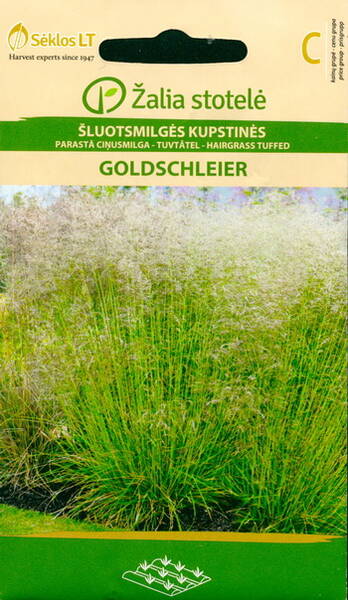An ornamental and attractive evergreen grass with neat dark green, slightly rough leaves and a mass of flowers forming a huge cloud.
This plant is interesting because it forms picturesque clumps of numerous thin leaves that resemble a tuft of disheveled hair. Grows to 60-70 cm in height. Very frost-resistant (-35 °C), thrives in both sun and shade. An easy and reliable plant for the garden in various climates, except for very hot and dry places.
Spikelet inflorescences appear in late June — early July, changing their color as they mature. The inflorescence is spike-shaped, wheat-yellow, and in autumn - golden.
Use: flower groups, mixed borders, solitaires, for decorating ponds.
Pairs well with many plants: Iris pseudacorus and Siberian irises, daylilies, any moisture-loving perennials.
Growing duration in one place: 4-5 years.
1.0 g = 2600 seeds.
Family: Poaceae, Gramineae.
Origin: Europe, Asia and North America.
Special Features: Brilliant silver-green, followed by golden-brown flower spikes, compact habit. Forms dense evergreen clumps. Especially cold hardy.
Colour: Silver-green spikes fading to decorative golden-brown Natural Flowering Period: June - September.
Winter Hardiness Zones: Z2-7.
Growth Habit: Thick clumps Foliage: Narrow evergreen leaves.
Height with Flowers: 60 cm.
Spacing between Plants: 45 cm.
Soil Requirements: Humus-rich, moist soils - even in bogs - over cooler summer regions, pH 5.8 - 6.8.
Location: Full sun to partial shade Use: Mass plantings look outstanding and can be combined with Euphorbia palustris, Luzula sylvatica and Primula japonica.
Specialities: Flowering stems - fresh or dried - make nice cut flowers.
Cultural Tips: Grams per 1000 Seeds: 0,185 Seeds per Gram: 5400 Seeding Recommendation: 1 g / 1000 plants.
Sowing Rate: 5-6 seeds per cell Plug tray recommended size(s): 128, 288.
Germination: Rapidly germinating, keep seed in constant moisture (not wet) with temperatures of about +20°C. Do not cover the seed but tightly press into the earth. Keep in cooler conditions after germination occurs. The germination might be slower and more irregular. This poses no problems.
Eng.: Tufted Hair-grass, Tussock grass. Bot.syn.: Aira caespitosa L.












